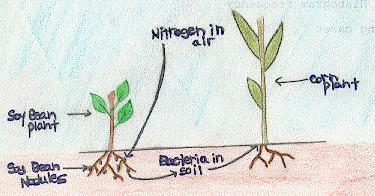Soybeans in the Farm Ecosystem
Do you have any idea where foods such as tofu and soy sauce start from? Well here's a hint: not from your grocery store!
Tofu and soy oil come from soy bean plants that are grown on farms. Many farmers grow soy beans as cash crops that they can send to places such as tofu processing plants. Soybean plants are legumes. Legumes have bacteria on nodules which are on the roots of the plant. The bacteria on the nodules takes nitrogen from the air and fixes it into the soil, so that other plants that require nitrogen can use it as well.
This nitrogen cycle that was breifly discussed above is used in what farmers call a crop rotation. Farmers use soybeans and other legumes in roatations with grass crops such as corn or wheat. Grass crops are unable to take their own nitrogen from the air so they either need the nitrogen in the soil that the legumes provide for them in a crop rotation or they need a chemical fertilizer containing nitrogen. Many farmers choose to use both. Most farmers use a two or four year rotation on their fields. In a two year rotation a farmer will alternate a year of a legume such as soybeans and a year of a grass crop such as corn. In a four year rotation a farmer will alternate back and forth between legumes and grass crops just as in a two year rotation, but instead he will use four differnt crops. For example, a farmer may plant a rotation of soybeans, corn, alfalfa (a legume), then wheat (a grass).
 |
Eco Info
Nitrogen gas makes up 78 percent of the atmosphere but in order for plants to use it, it has to be broken down through the nitrogen cycle into a less mobile form. | |

This diagram shows the nitrogen cycle that farmers use in their crop rotations.
Image by Kirstin Yogg
|





